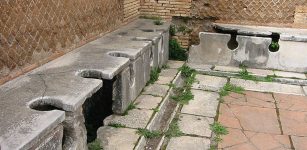Mystery Of The Vittrup Man – Bog Body Of A Foreigner In Neolithic Denmark
Ellen Lloyd - AncientPages.com - The Vittrup Man, a bog body, was unearthed in 1915 in the Northwestern region of Denmark. The remains, which were significantly damaged, were found during a peat-cutting operation along with a wooden club, ceramic vessel, and bovine bones. This Neolithic man was estimated to be between 30 to 40 years old at the time of his death. All evidence points towards him being subjected to ritualistic sacrifice - a prevalent practice in this region during that era.
To the left you can see the cranial remains of Vittrup Man, who ended up in a bog after his skull had been crushed by at least eight heavy blows. Photo: Stephen Freiheit. Image Credit: Fischer et al., 2024, PLOS ONE, CC-BY 4.0. The entire image compilation was made by AncientPages.com
According to Anders Fischer of the University of Gothenburg, Sweden, and his team who studied the bog boy, "the impact lesions on the skull are characterized by oval fractures with larger radiating fracture lines. Such damages are described in the forensic anthropological literature on skeletal traces of fatal violence—e.g., - and are known from other Neolithic human skeletons.
They suggest blunt force caused by contact with an object made of more resilient material than the skull bone, possibly with a rounded surface and a diameter of a minimum of 2 cm. The wooden club found next to the skeletal remains would have been a weapon likely to produce these fractures." 1
Further analysis of his skeletal remains suggested that he lived around 3,300-3,100 BC and was not a local man. Who was this foreigner? Where did he come from, and why had he reached Denmark? These were some of the many questions scientists decided to investigate.
End of life for Vittrup Man. Credit: Anders Fischer (contents) and Niels Bach (drawing), CC-BY 4.0
The isotopes of strontium, carbon, and oxygen found in the tooth enamel of Vittrup Man suggest that his early years were spent on the Scandinavian Peninsula's coast. Genetic analysis further supports this by showing a close link between Vittrup Man and Mesolithic inhabitants from Norway and Sweden. Further analysis of isotopes and proteins in his teeth and bones indicate a dietary shift from coastal food sources such as marine mammals and fish during his early life to farm food, including sheep or goat, during his later years. This transition appears to have occurred during his late teenage years.
The research suggests that Vittrup Man probably spent his early life in a northern hunting and gathering community before relocating to an agricultural society in Denmark. The motives for this move are not entirely clear. Still, researchers suggest that he might have been a trader or captive subsequently integrated into the local population. Despite some unresolved queries surrounding Vittrup Man, this detailed examination of his geographical and dietary past provides new insights into the relationships between European Mesolithic and Neolithic societies.
Everything now breathes peace at the site in the river valley, where the dramatically maltreated
remains of Vittrup Man were deposited in Neolithic times. The peat cut from 1915 has long since been filled in and overgrown. Credit: Anders Fischer
Bog bodies discovered in Scandinavia have been found to originate from significantly distant regions. For instance, research into the bog body Haraldskærkvinnan, found in Denmark, indicates that she had undertaken a long journey just before her demise. Similarly, the Egtved girl's bog body revealed that she was not native to Denmark but originated from an area hundreds of kilometers away from the Egtved region.
The Vittrup Man is a unique genetic foreigner among Neolithic Denmark's population. His lineage aligns closely with Mesolithic individuals from the Scandinavian Peninsula, and there is no substantial evidence of genetic intermingling with Neolithic farmers. Furthermore, he remains the sole individual from Denmark's Funnel Beaker period whose non-local strontium signature has been documented in published research.
"His dietary isotope values indicate that during his teenage years, he switched from a fisher-hunter-gatherer diet to that of a farmer, and during the last many years of life his diet was similar to that of the majority of contemporary individuals found in Denmark. Thus, during his years of maximal physical labor capacity, Vittrup Man lived in a farming society, probably hundreds and possibly more than a thousand kilometers from his childhood home. Many explanations for such a drastic change in life-style and geography are possible, as exemplified in ethnographic and early historic sources.
The refitted fragments of a lugged vase, which was probably deposited in the bog some centuries before the human remains. The rim part is missing. Maximum width 19 cm. Credit: John Lee, Danish National Museum.
He may have been an immigrant or trader who became integrated into equal social standing as other local Funnel Beaker society members. He could also have been a captive/slave providing labor and possibly maritime skills. However, neither his way of death nor his lifestyle allows definite conclusions as to his social standing," the scientists write in their study.
Europe's bog bodies have long fascinated scientists. However, despite rigorous research efforts, it is only now that researchers have comprehensively understood this intriguing bog body phenomenon.
Examinations of bog bodies such as the Vittrup Man, the Haraldskærkvinnan, the Elling Woman, the Egtved girl, and many others provide valuable information about the ancient past.
Written by Ellen Lloyd - AncientPages.com
Copyright © AncientPages.com All rights reserved. This material may not be published, broadcast, rewritten or redistributed in whole or part without the express written permission of AncientPages.com
- Vittrup Man–The life-history of a genetic foreigner in Neolithic Denmark, PLoS ONE (2024). DOI: 10.1371/journal.pone.0297032
Jan Bartek - Mystery Of Europe’s Bog Body Phenomenon Solved By Scientists - AncientPages.com
More From Ancient Pages
-
 New System Will Give Stone Age Skeletons And Mummies Unique Names
Archaeology | Oct 2, 2024
New System Will Give Stone Age Skeletons And Mummies Unique Names
Archaeology | Oct 2, 2024 -
 What Were Ancient Egyptian Schools Like?
Ancient History Facts | Jul 14, 2016
What Were Ancient Egyptian Schools Like?
Ancient History Facts | Jul 14, 2016 -
 Saqqara Necropolis: Biggest Archaeological Discovery In 2020 – Photos Revealed
Archaeology | Nov 14, 2020
Saqqara Necropolis: Biggest Archaeological Discovery In 2020 – Photos Revealed
Archaeology | Nov 14, 2020 -
 The Romans Spread Parasites – Their Hygienic Innovations Gave No Health Benefit
Archaeology | Jan 9, 2016
The Romans Spread Parasites – Their Hygienic Innovations Gave No Health Benefit
Archaeology | Jan 9, 2016 -
 Incredible Find – 3,000-Year-Old Canoe Found In Wisconsin’s Lake Mendota
Archaeology | Sep 25, 2022
Incredible Find – 3,000-Year-Old Canoe Found In Wisconsin’s Lake Mendota
Archaeology | Sep 25, 2022 -
 A Graffiti Inscription With The Name Of Knight Adrian von Bubenberg – Found On Mount Zion In Jerusalem
Archaeology | Nov 30, 2022
A Graffiti Inscription With The Name Of Knight Adrian von Bubenberg – Found On Mount Zion In Jerusalem
Archaeology | Nov 30, 2022 -
 French Grotte de Cussac Cave Reveals Secrets On Life And Death 25,000-30,000 Years Ago
Archaeology | Jun 22, 2020
French Grotte de Cussac Cave Reveals Secrets On Life And Death 25,000-30,000 Years Ago
Archaeology | Jun 22, 2020 -
 Highly Advanced Robots In Ancient China
Ancient Technology | Aug 7, 2015
Highly Advanced Robots In Ancient China
Ancient Technology | Aug 7, 2015 -
 Ancient Maya Destroyed Their Environment 2,000 Years Ago – Effects Are Still Visible Today
Civilizations | Sep 9, 2015
Ancient Maya Destroyed Their Environment 2,000 Years Ago – Effects Are Still Visible Today
Civilizations | Sep 9, 2015 -
 Rudolf II: Eccentric Holy Roman Emperor Whose Occult Interest And Mistakes Led To The Thirty Years’ War
Featured Stories | Apr 9, 2021
Rudolf II: Eccentric Holy Roman Emperor Whose Occult Interest And Mistakes Led To The Thirty Years’ War
Featured Stories | Apr 9, 2021 -
 9,000-Years-Old Underwater Artifacts Found Off The Western Australia Pilbara Coast – Protect Flying Foam Passage Scientists Say
Archaeology | Jun 27, 2023
9,000-Years-Old Underwater Artifacts Found Off The Western Australia Pilbara Coast – Protect Flying Foam Passage Scientists Say
Archaeology | Jun 27, 2023 -
 The Oldest Denisovan Fossils Ever Discovered Shed New Light On Early Hominins As They Spread Across Eurasia
Archaeology | Nov 30, 2021
The Oldest Denisovan Fossils Ever Discovered Shed New Light On Early Hominins As They Spread Across Eurasia
Archaeology | Nov 30, 2021 -
 Something Unexpected Stopped Mongol Hordes From Conquering Europe
Featured Stories | Jul 11, 2017
Something Unexpected Stopped Mongol Hordes From Conquering Europe
Featured Stories | Jul 11, 2017 -
 Underground Civilizations – True Rulers Of Earth – Part 1
Featured Stories | May 7, 2019
Underground Civilizations – True Rulers Of Earth – Part 1
Featured Stories | May 7, 2019 -
 Mystery Of Ancient, Overlooked Calico: Early Man Site In The Mojave Desert Of North America
Civilizations | Sep 9, 2021
Mystery Of Ancient, Overlooked Calico: Early Man Site In The Mojave Desert Of North America
Civilizations | Sep 9, 2021 -
 On This Day In History: The Name Of America Used For The First Time On World Map – On Apr 25, 1507
News | Apr 25, 2016
On This Day In History: The Name Of America Used For The First Time On World Map – On Apr 25, 1507
News | Apr 25, 2016 -
 Kudurru Of Melishihu – Stone Records From The Kassite Dynasty In Babylonia
Artifacts | Jan 17, 2016
Kudurru Of Melishihu – Stone Records From The Kassite Dynasty In Babylonia
Artifacts | Jan 17, 2016 -
 Mystery Of Egyptian Queen Hetepheres I’s Bracelets Solved!
Archaeology | Jun 2, 2023
Mystery Of Egyptian Queen Hetepheres I’s Bracelets Solved!
Archaeology | Jun 2, 2023 -
 Munkholmen: Island With Intriguing Yet Dark And Scary History
Featured Stories | Aug 25, 2023
Munkholmen: Island With Intriguing Yet Dark And Scary History
Featured Stories | Aug 25, 2023 -
 Aaru – Field Of Reeds: Kingdom Of Osiris Was The Ancient Egyptian Paradise
Myths & Legends | Feb 29, 2024
Aaru – Field Of Reeds: Kingdom Of Osiris Was The Ancient Egyptian Paradise
Myths & Legends | Feb 29, 2024




